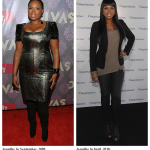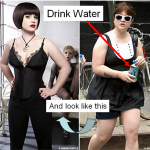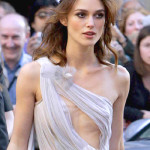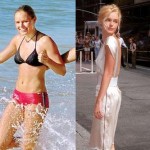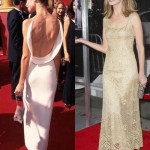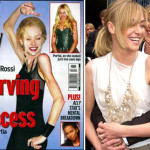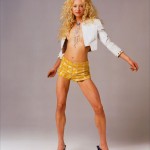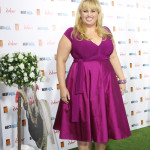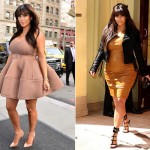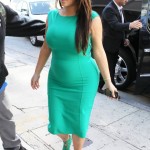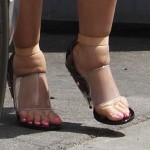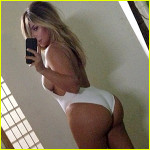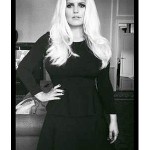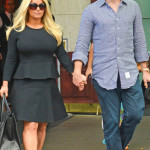I came across Melissa Harris Perry’s 2011 lecture at University of California on her book Sister Citizen: Shame Stereotypes and Black Women in America. In Sister Citizen she juxtaposes the results of the 1953 cognitive perception study of the Crooked Room to the being a Black woman in America.
The Crooked Room experiment goes as follows:
They sit a person in a dark room in a chair that tilts. When the lights come on everything in the room is set at an angle. The participants are then observed to see if they can find, or maintain their true upright despite what their eyes tell them. The result was that most people would actually try to tilt the chair to match the angle of the crooked room; few could find their true upright.
Harris-Perry sees the stereotypical images of Black women in America (Jezebel’s sexual lasciviousness, Mammy’s devotion, and Sapphire’s outspoken anger) as the “crooked images” that African American women are either tilting to match, or overcompensating against. These images create a virtual “crooked room” through which they must navigate, and which also shapes their experiences as citizens. This got me thinking about the images of the hyper-sexualized, over commercialized exploited and distorted images of female body that we see in the world today.
As women are living in a Crooked Room of the Female Image the question is, just how crooked is this room that we inhabit? Let’s look at some basic statistics. The average height and dress size of an American woman is 5’3 and a size 14, the average height and size of a fashion model is 5’11 and a size 4, that is huge differential. Is it any wonder that that most women find themselves tilting to fit that angle? Add to that, all media images are digitally manipulated to erase any perceived flaws and even alter the model’s body shape and size. Even the size 4 models are minimized. The room tilts a bit further on the angle. These magazines and ads create a concept of “beauty” that does not in real life, it is completely and utterly unobtainable, so what chance do “real” women have to find their center when we are living on a Tilt-a Whirl ride?
The most interesting aspect of the Crooked Room of the Female Image is that we all know that the images we are presented with are warped. Where the subjects in the 1953 study were unaware and caught off guard as to what to expect when the lights came on, we as women are completely cognizant of the visual and emotional manipulation ubiquitously visited upon us and yet we are still tilting or chairs trying to align ourselves to it. Our information driven society has created a demand for full disclosure, we want to go behind the scenes of movies and photo-shoots to see how things are made. Where once we could only suspect that someone’s image had been tampered with, now we can see the technology that warps these images. It is no longer a question of our “lying eyes” it is fact and yet, we in our real, un-retouched lives are still charging ourselves with matching the standard.
I grew up in not in just a Crooked Room as a woman, but a Crooked House as a Black Woman, and that house was located at the end of a cul-de-sac in crooked gated community of Dance. One cannot find a more crooked room then a dance studio. Where the dance world is fraught with twisted body ideals (especially the ballet world) as an African American girl/woman in that world, I was not only tilted I was set upside down. The fact that I was brown (which is the antithesis of the image of the ballerina) I was tall, muscular, and visibly strong (the preferred aesthetic for a ballerina is slight and lithe, which visibly belies the amazing physical strength it takes to be that graceful) plus after puberty I had thighs and a booty. As a female ballet student, acquiring your first body image issue is akin to getting your first pair of pointe shoes, it is a rite of passage, and like pointe shoes that body issue is just the first of many you will go through in your training and career. We [dancers] were all gifted lifetime subscriptions to body issues that range from basic physical inadequacy (relative to our facility), to our actual body shape, form or weight. Our identities exist in the physical, how high our legs go, how arched our feet are, how many turns we can do, and how we measure up to the girl who is standing next to, in front of, or behind us who, we are charged to look exactly like…in classical ballet physical individuality can be like sudden death, the key to survival at ground level, is to blend. Have you ever gone to see a friend dance in the corps de ballet in Swan Lake? Good luck finding her *unless she is brownish…
In her lecture on Sister Citizen, Harris-Perry speaks a great deal about the power of shame when it comes to African American women identifying or being identified with those inaccurate, negative images. In the dance world body shaming is almost a foundational teaching tool. You can be shamed for not being able to execute the technique and movements properly, or for just not fitting the ideal aesthetic, or you could be a proxy for the lingering issues harbored by a teacher who lived in that crooked room before you. This “shaming” can take the form of weigh-ins and measuring, comments made about a girl’s body parts in class, or references made about her weight in partnering class. It is often acceptable for both teachers (male and female) and students (male and female) to comment, make snide remarks (openly or behind a girl’s back) about her weight or ability, it is woven into the culture. The shaming is not always verbal, it happens when you are consistently placed in back lines in class, not chosen for groups, or casting (when your actual ability is not a factor) or by simply being invisible- unseen, ignored, which equated to being un worthy of being, seen corrected, or taught. Often when young girls enter puberty they become invisible. Teachers wait to see how they will emerge on the other side. As breasts bud and hips spread they say nothing. This is the most dangerous and vulnerable time for a young girl in the studio, she can see her changing body as her getting fat and go to drastic measures to “correct it. A very clear-cut pop culture reference, which wrenches my soul, (as I know that when I write this, you will get it) is reality television personality Abby Lee, from Dance Moms… Clear enough for you? Now that is sensationalized but it resonates because anyone who has trained in dance is somewhat familiar with that tone and humiliation. * It is less common now because the parameters of abuse have been broadened.
I sat with a coworker a fellow dancer/teacher who told me that he loved those skinny, beautiful girls, even if they couldn’t hit the step, he said didn’t even want to look at heavy girls. He needed to be inspired… Now I found his comment particularly interesting and irksome considering that he himself is thick of thigh and behind. If he were a woman, he would probably not want to see himself dance—here we have that all too familiar syndrome were people support things that exclude them. People will vote against their own best interests. The idea that he so glibly could say that in his smug, aloof manner with his penis snuggled safely between his legs, making certain that he would NEVER have to be held to the same body or talent standard of a female dancer made my blood boil and my teeth itch. The reality is, if a man can partner he can get a job somewhere, whether he can balance on two feet or not, This is the culture of the Crooked Dance Room, try coming out of it with any sense of equilibrium it takes all the Pilates, Gyrotonics and core support to emerge standing. It is not for the faint of heart…
Where the World of concert dance is very specialized, we see evidence of the Crooked Room in action in the mainstream regularly when a young starlet emerges onto the scene that does not fit comfortably into the manufactured ideal. If she is curvy, with her increased success her body as well as her nose will get slimmer, her hair will get blonder and blonder, if she can survive she will morph into, or closer to the commercial ideal. Jennifer Hudson shrinks before our eyes; Kelly Osbou
rne, Kelly Clarkson, Demi Lovato and Miley Cyrus have all had physical reducing body transformations. We see the media chronicling their weight fluctuations seemingly more than their career achievements. Even the girls who are “ideal” go further almost disappearing before our eyes in an effort to… be seen: Kate Bosworth, Keira Knightly, and Lindsey Lohan. I recall vividly when this was illustrated in the 90’s with the Ally McBeal era Calista Flockhart and Portia de Rossi and all the women on that show were scarily thin and kept getting thinner as the skirts got shorter.
There are a few non-traditional females in the industry who have found their upright in the Crooked Room of the entertainment industry Adele, Rebel Wilson, and Melissa McCarthy come to mind (two of which are comedians- funny girls are allowed to be fat, ‘cause they giggle when they laugh). Adele has publicly and personally declared power over her body and her image; she is fine with who she is and what she looks like and has not made the physical concessions to be marketable. Just recently she turned down a 19 million dollar contract to be the face of L’Oreal, reportedly because she is focusing on her music —what she actually does, imagine THAT concept. McCarthy and Wilson have a “Fat Pact” they have agreed not to “change” for the industry.
The newest tilt of the room is the obsession with the “post pregnancy bodies” of women. At some point there was a competition launched to see who could have a baby and snap her body back in shape before the placenta was pressed out. Women today in the public eye are not afforded a break from the Crooked Room standard when going through the most organic process a woman’s body was built for. She now must adhere to the standard before, during and after her pregnancy, and should she some how not participate in the competition then she is shamed and ridiculed for being fat. Jessica Simpson was one of the first women to endure the public gauntlet of the media cruelly commenting on her pregnancy weight gain. It was as though they were pissed that (even though with child) she was defying her bombshell sex symbol image. She, with her pregnancy, and her unwillingness to play by the MILF in the making game (which kind of looks like you have a basketball tucked under your shirt) she reclaimed her body by letting it spread unapologetically. She ate what she wanted and grew larger and larger, and wore printed flowing moo moos and reveled in her impending motherhood. It seems like in her pregnancy found her upright. Pregnancy had set her free from the obligatory sex symbol pop star body type she had become famous for. The responsibility of “eating for two” released her from the obligation of starving for one in order to look “hot” in a pair of “Daisy Dukes”. For Simpson the ultimate act of female creation (or procreation) somehow set the room right.

Conversely Kim Kardashian went into full tilt during her pregnancy. She fought the organic push to upright with all her might and the
strongest Spanx reality television money could buy. Unable to surrender her sex symbol image, when her pregnancy weight began to show she often wore clothes and shoes that, though fashionable were ill-fitting, and though meant to be sexy, made her looked stuffed into, and uncomfortable. Her fame, and apparently her entire identity hinged precariously on her sex appeal. Yes she is known for her zaftig fuller figure, the classic hourglass that represents “womanliness” and “Femininity” yet when challenged with the ultimate act of femininity, pregnancy she had trouble embracing it. She cashed in on the media manufactured concept of beauty and sexuality, but when the authentic aspects of being a woman touched her life she repudiated them with ill-fitting couture. Like Sampson and his locks Kardashian’s power lie solely in her waist to hip ratio, and when were waistline expanded she stuck to her sexy girl equation but unfortunately the math it didn’t balance.
She took heat for it in the media, but for different reasons then Simpson, yes they were both abandoning their bombshell bodies but they were treated with the same rancor for divergent reasons. Where the media chastised Simpson for not giving a damn and ballooning and loosing her figure while pregnant and, they berated Kardashian for not accepting and embracing her pregnancy and changing body, she almost tried to ignore the changes which for some reason incited people. Both women were damned if they did, damned if they didn’t. The Crooked Room sways precariously. Both were accepted back into the fold when they, like many other new celebrity mothers fulfilled their contract of restoring their post baby bodies to appropriate hotness. Kim posted the white one-piece bathing suit shot of her ass, to show all the “haters” that she was back to hot, and sadly still seeking the approval and validation of the masses. However Simpson seems to have stepped out of the Crooked Room altogether. After having her children, she has not only embraced her post baby body (which is fuller then her former pop star frame) but she is no longer, chasing singing contracts or acting roles. She is not seeking acceptance or validation from the media or the world. She has built an empire that includes a clothing and accessory line that is grosses billions. She has come a long way from the girl who didn’t know that the “chicken of the sea” was in fact fish.
Now an argument could be made that the Crooked Room of the Female Image might be tilting back upwards when we think of the new “curvy girl” movement. The poster girls for women with curves are the likes of previously mentioned Kim Kardashian, Jessica Simpson and Beyoncé, as well as Jennifer Lopez and Sofia Vegara. Where these ladies are not the typical size 00, and are still considered sexy and desirable, so where their curves might create a slight shift to the upright, their hyper sexualized images and “bombshell” labels in a way tilts it right back. They could be lauded solely for their authentic talent (okay for some of the examples that does not really apply) albeit their overly exposed bodies and images at times overshadow their work and their business acumen. All of these “Curvy” girls still lean into the tilt aesthetically, which in a ways nullifies the seeming correction. The few women whose weight (pun fully intended) could actually shift the scales (yeah that one too) are the likes of the previously mentioned Adele, Rebel Wilson, and Melissa McCarthy, and perhaps Glee’s Amber Riley.
There is no question as to whether or not the room is indeed crooked, and we agree that there are indisputably, unrealistic images of women projected at us at every turn. We know that the women walking down the runways at every fashion week are either fresh out of puberty or have spent the last month sucking on lemon soaked cotton balls, chain smoking, or doing coke to stay thin. We also concede their printed images could be considered virtual paintings after being airbrushed. We know that most actresses pay exurbanite amounts of money on glams squads of trainers, make-up artists and hair and fashion stylists, nutritionists, and chefs not to mention plastic surgeons to achieve a “look”. In short we all know that the projected image of “woman” is truly just that a projection, not real something that has been manufactured… so what do we do with that? How are we exactly supposed to find our natural upright? How do we self correct?
When Scuba divers become disoriented under water and lose their sense of direction, unable to discern which way is up, they are taught to follow their air bubbles. Bubbles always float to the surface. That having been stated, the diver first has to realize that they are in fact disoriented; they have to on some level get their bearings in order to find themselves. Women too must get our bearing in this warped environment of the female image. It is akin to addiction, and the 12 steps program, the first step is to realize and admit that you have a problem. Once you realize that it is the room that is crooked, not you, once you can see that it is the projection of beauty and the female form that has been twisted, and manipulated and that the reflection of your Self is the actual reality, the truth… only then can you begin to start look for, and find your center. Once you can get your mind around the fact that you are not broken the bubbles will appear. In order to follow our bubbles to the surface of ourselves and emerge upright, we as women in the Crooked Room of the Female Image have to first identify what those bubbles are so that we can train our eyes and minds on what will lead us out of the murky depths of this oppressive existence?
Creating Bubbles
In the Crooked Room we are taught to look towards images in fashion and the media that do not resemble us, usually they are taller, thinner (lighter) then we actually are, that is when we start to tilt. We can create a guiding bubble that acknowledges these images as a form of animation, the over exaggerated products of someone’s imagination and fantasy that has little to nothing to do with us as real, living, breathing, eating women. Real women have curves, wrinkles, fat, sagging parts, stretch marks and hair on places other then their heads…and just for the record so do men (only sometimes they lack hair on their heads).
These animations weight the room to one side. We can create buoyancy within ourselves if we stop or even limit the intake of that information. I know that when I look at fashion magazines, or watch certain television shows I find myself feeling crappy. For example I was in Bulgaria this summer, when in my hotel room I would absentmindedly turn on the television to keep my company. I have noticed that in Bulgaria (and a number of places in Europe) they are almost obsessed with Fashion TV, a network dedicated to the behind the scenes happenings of fashion shows and highlights models. It took be about 3 days for me to realize the tilt… at the beginning of my trip I was feeling a few pounds heavy, but I was fine with it. I knew that once there I would drop weight. In Bulgaria salads are the staple of almost every meal and there is virtually no snacking, it was like a culturally imposed fat camp. After 3 days of watching emaciated models walking runways in my room I felt the pressure, I was not merely 5 pounds over weight I was full on FAT, my ass was too big, as were my thighs and I was ugly. I was tilting, losing my sense of center… I turned the television off. It was like the room sighed, the walls started to widen, the tension slowly began to dissipate. Out of boredom I had made the fatal mistake of consuming something designed to destroy me.
Years before I realized that I had to “change my diet of media intake” I had a subscription to InStyle magazine and very single time I read it felt, ugly, fat, and poor. I started to ask myself “Why do I read this if it makes me feel so bad?” I stopped my subscription, I also stopped reading fashion magazines altogether. I stopped watching shows that in any way, shape, or form were perpetuating the image, and notion that in order to be beautiful, attractive, desirable, or worthy I had to look, or act a certain way, or have certain things. It took a surprisingly short time to feel the room straightening out. I noticed that when I was having a good day, when I felt good in my body, or I liked the way that I looked, I could sustain that feeling for longer periods of time if I was not exposed to media influence. I found that I could hold on to that positive feeling until an ad on a bus, or billboard knocked me sideways. The great lesson I learned was that I did in fact have some control over the balance of this Crooked Room. Even though it seemed ubiquitous and omnipresent I could in fact manage it by censoring and limiting my intake of negative images. It was a bubble…
One of the best bubbles I look for is one that we can create ourselves, when we can start to actively look for images in our daily lives that resemble ourselves that we find attractive, or beautiful. That sounds narcissistic, and it probably would be if we thought too highly of ourselves, but we don’t, so it can be a reassuring tool. Often it is easier to acknowledge, accept and appreciate positive characteristics in others then in ourselves. It is easier for us to claim the negative characteristics that we recognize and relate to, and it feels wrong, to acknowledge the positive. This bubble uses simple reason to rebuild or reestablish a more accurate sense of self. Say you hate your nose and lips, when you can see those similar features on someone else and you find them beautiful, then it stands to reason that you can then see your nose and lips as beautiful too. When we can begin to look out into the real world and find beauty in other women who share physical characteristics similar to our own, and we can objectively see them as appealing, we blow a bubble that floats upwards, and if we follow it we can start to right ourselves.
The exercise of looking for one’s self in others begets another important, substantial, and empowering bubble, which is that of creating your own definition and standard of beauty that first and foremost includes you. Each time you recognize beauty in another with whom you share like attributes, you reprogram not only how and where you see beauty, but also fundamentally what you find to be beautiful. Instead of looking for what’s broken in someone you start to see what’s working. We are not looking for perfection, but for truth. What starts to emerge is an appreciation for the infinite diversity that is humanity. You start to appreciate the beauty of shape, form, color and texture, the things that make up mankind. You begin to marvel at how physiologically we are all alike, and yet intrinsically different at the same time. That is beauty. When you can begin to see beauty- or even the validity of someone’s right to be exactly who and what they are (you don’t have to like it, or agree with it) but you honor them by respecting it, you invariably create a space for you too to be exactly who and what you are with out exception, without qualification. Then you can follow your bubbles upwards, break the surface and breath deeply.
It would be folly to think that one-day the crookedness of the female body image will cease to exist. The reality is beauty and the body is a crooked business; billions of dollars are spent on people trying to “match the angle”. Just like sex, in adequacy sells, when you can convince people that they are inherently broken, they will always look for the fix, the cure, or the camouflage. The sale of beauty is predicated on making someone feel less than. We also have to face the fact that the Crooked Room we exist in does not so much warp the mirrors; as much as it twists the way we see our images in them. They are akin to funhouse mirrors, when we look at ourselves, we do not see our true images. When we can find our centers, and see the Crooked Room of the Female image as a room and that is crooked, and not us, then we can finally begin to orient ourselves, exhale and follow the bubbles upward, break through and exit that room closing the door firmly and completely behind us.


